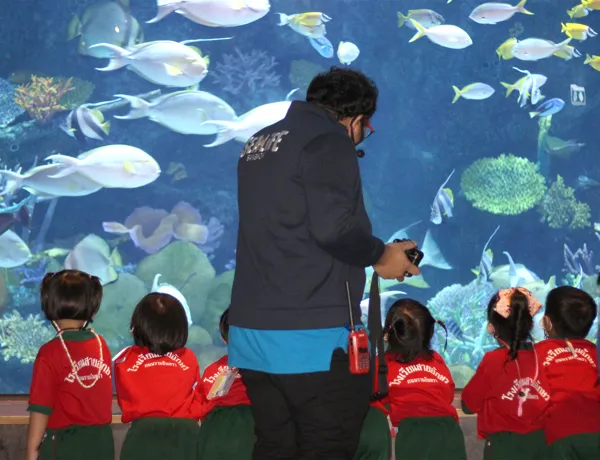Programs for Different Age Groups

Early Childhood Program
This Early Childhood Program at SEA LIFE Bangkok Ocean World Aquarium is designed as an early childhood education programme to improve their educational experiences in addition to the aquarium journey. Colourful and exciting interactive marine animal-related games have been introduced to educate kids about the colour, size, shape and relationship of humans to sea life. (Minimum booking: 50 students)

The Ocean Adventure 1 for Junior Primary Level
This great program looks at how animals survive in their natural environment. Students learn about the ‘adaptations’ animals have that allow them to find food while not becoming food themselves. (Minimum booking: 50 students)

The Ocean Adventure 2 for Senior Primary Level
This is a more advanced program looking at animal behaviours and adaptation’ that help them survive in an aquatic environment. Students work in groups with our Education Officers to solve problems. (Minimum booking: 50 students)

The Ocean Adventure 3 for Secondary Level
It is a more challenging program that looks into the physical, morphological and behavioral adaptations of animals and how they use them to survive." (Minimum booking: 50 students)
Special Rates for Experiences

4D cinema
Enjoy watching a movie with a special 4D experience!

Glass Bottom Boat
A ride on the 'Glass Bottom Boat' allows you to come up close to sharks and stingrays, only separated by a crystal clear window.
Learn More About The Survivor Program
The Survivor Program is an exclusive school program at SEA LIFE Bangkok Ocean World Aquarium, and is based on the ecological concept of Adaptations.
An adaptation is anything that helps an organism survive and reproduce successfully in its habitat.
- A structural adaptation is a physical structure you can observe on an animal. For example, the false ‘nose’ of the Anglerfish acts as a lure to attract prey.
- A behavioural adaptation is shown by the behaviour of an animal. For example, Clownfish ‘hide’ from predators amongst the stinging tentacles of anemones.
- A functional adaptation is generally an internal physiological characteristic. For example, the venom produced in the Lionfish enables it to safely swim in open waters, without being eaten by potential predators.
- To survive, animals must obtain water, food and oxygen; find a mate and reproduce; and protect themselves from predators and the surrounding environment.
- There are certain ‘rules’ that need to be followed to survive in underwater environments.
- These ‘rules’ are grouped into structural, behavioral and functional adaptations.